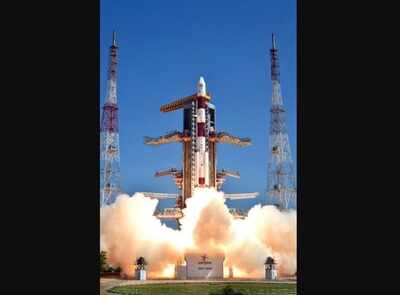
NEW DELHI: With the country’s security in mind, Indian Space Research Organisation (Isro) is gearing up to launch an unprecedented 10 earth observation satellites with space surveillance feature during 2020-21, according to the annual report of the Department of Space.
In comparison to 10 earth observation (EO) satellites, only three communication satellites and two navigation satellites are scheduled to be launched in the next financial year starting April this year. In the past, Isro had never given so much impetus in boosting its surveillance powers and the focus was more on communication satellites. A huge number of EO satellites suggests Isro’s priority is to boost space surveillance in order to keep an eye on terror launchpads along the borders, checking infiltration and keeping an eye on China’s naval activities in the Indian Ocean Region.
For the current fiscal year 2019-20, Isro has planned 17 missions. Of these, six are yet to be completed and are expected to be launched by March 31. Of the six EO satellites planned, four have been launched and two are likely by the end of the current fiscal. In fiscal year 2021-22, the space agency will target to add eight more EO satellites.
Besides their widespread use for civil applications related to land, water and environment like agriculture, forestry and water resource management, EO satellites are actually “eyes in the sky” that provide constant surveillance.
The 10 earth observation (EO) satellites include the high-tech Geo Imaging Satellite Gisat-1 that has the capability to do real-time earth imaging. “Gisat-1 will do a full rotation of the Earth and come to the same point after every 2 hours. It is really good for fast imaging of the Earth and can perform constant and rapid surveillance. If needed, the satellite can observe a point for a longer duration,” says a source in Isro.
The other EO satellites include highly advanced radar imaging satellites RISAT-2BR2, RISAT- 1A and 2A (with high agility X-band synthetic aperture radar), Oceansat-3 and Resourcesat-3/3A & SA. Risat satellites with high-spatial resolution will provide all-weather, day and night imaging services from space. They will be good for space surveillance and will mainly be used by security forces.
According to the annual report, Isro has planned in all 36 missions, including satellites and launchers, in 2020-21. These missions include the launch of three space science satellites, one technology demonstrator test, two small satellite launch vehicle demonstration tests, 10 PSLVs, three GSLV Mk-II, one GSLV-MkIII and one unmanned flight of Gaganyaan in 2020-21.
Isro is also planning to launch a new series of high-resolution satellites (HRSATs) that will be a constellation of three satellites packed together in a PSLV. These three satellites will be placed in space to provide systematic coverage of high resolution panchromatic and multispectral data. They will provide images with better than 1.0 m resolution with 15 km swath. The constellation is meant for large-scale land mapping.
A budget of Rs 13,480 crore has been proposed for the next fiscal in the recent budget for the Department of Space. Of it, Rs 265 has been allocated under the Space Sciences category and Rs 750 crore under the Insat Satellite System category. Most of the EO satellites to be launched in 2020-21 will be funded from the money allocated under these two categories.
In comparison to 10 earth observation (EO) satellites, only three communication satellites and two navigation satellites are scheduled to be launched in the next financial year starting April this year. In the past, Isro had never given so much impetus in boosting its surveillance powers and the focus was more on communication satellites. A huge number of EO satellites suggests Isro’s priority is to boost space surveillance in order to keep an eye on terror launchpads along the borders, checking infiltration and keeping an eye on China’s naval activities in the Indian Ocean Region.
For the current fiscal year 2019-20, Isro has planned 17 missions. Of these, six are yet to be completed and are expected to be launched by March 31. Of the six EO satellites planned, four have been launched and two are likely by the end of the current fiscal. In fiscal year 2021-22, the space agency will target to add eight more EO satellites.
Besides their widespread use for civil applications related to land, water and environment like agriculture, forestry and water resource management, EO satellites are actually “eyes in the sky” that provide constant surveillance.
The 10 earth observation (EO) satellites include the high-tech Geo Imaging Satellite Gisat-1 that has the capability to do real-time earth imaging. “Gisat-1 will do a full rotation of the Earth and come to the same point after every 2 hours. It is really good for fast imaging of the Earth and can perform constant and rapid surveillance. If needed, the satellite can observe a point for a longer duration,” says a source in Isro.
The other EO satellites include highly advanced radar imaging satellites RISAT-2BR2, RISAT- 1A and 2A (with high agility X-band synthetic aperture radar), Oceansat-3 and Resourcesat-3/3A & SA. Risat satellites with high-spatial resolution will provide all-weather, day and night imaging services from space. They will be good for space surveillance and will mainly be used by security forces.
According to the annual report, Isro has planned in all 36 missions, including satellites and launchers, in 2020-21. These missions include the launch of three space science satellites, one technology demonstrator test, two small satellite launch vehicle demonstration tests, 10 PSLVs, three GSLV Mk-II, one GSLV-MkIII and one unmanned flight of Gaganyaan in 2020-21.
Isro is also planning to launch a new series of high-resolution satellites (HRSATs) that will be a constellation of three satellites packed together in a PSLV. These three satellites will be placed in space to provide systematic coverage of high resolution panchromatic and multispectral data. They will provide images with better than 1.0 m resolution with 15 km swath. The constellation is meant for large-scale land mapping.
A budget of Rs 13,480 crore has been proposed for the next fiscal in the recent budget for the Department of Space. Of it, Rs 265 has been allocated under the Space Sciences category and Rs 750 crore under the Insat Satellite System category. Most of the EO satellites to be launched in 2020-21 will be funded from the money allocated under these two categories.
Download The Times of India News App for Latest India News.
more from times of india news
Get the app









